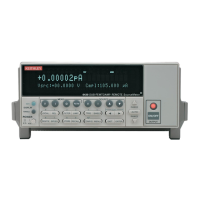IEEE-488 Bus Overview D-5
Bus management lines
The five bus management lines help to ensure proper interface control and management.
These lines are used to send the uniline commands.
ATN (Attention) — The ATN line is one of the more important management lines. The
state of this line determines how information on the data bus is to be interpreted.
IFC (Interface Clear) — As the name implies, the IFC line controls clearing of instruments
from the bus.
REN (Remote Enable) — The REN line is used to place the instrument on the bus in the
remote mode.
EOI (End or Identify) — The EOI is usually used to mark the end of a multi-byte data
transfer sequence.
SRQ (Service Request) — This line is used by devices when they require service from the
controller.
Handshake lines
The bus handshake lines operate in an interlocked sequence. This method ensures reliable
data transmission regardless of the transfer rate. Generally, data transfer will occur at a rate
determined by the slowest active device on the bus.
One of the three handshake lines is controlled by the source (the talker sending information),
while the remaining two lines are controlled by accepting devices (the listener or listeners
receiving the information). The three handshake lines are:
DAV (DATA VALID) — The source controls the state of the DAV line to indicate to any
listening devices whether or not data bus information is valid.
NRFD (Not Ready For Data) — The acceptor controls the state of NRFD. It is used to sig-
nal to the transmitting device to hold off the byte transfer sequence until the accepting device is
ready.
NDAC (Not Data Accepted) — NDAC is also controlled by the accepting device. The
state of NDAC tells the source whether or not the device has accepted the data byte.
The complete handshake sequence for one data byte is shown in Figure D-2. Once data is
placed on the data lines, the source checks to see that NRFD is high, indicating that all active
devices are ready. At the same time, NDAC should be low from the previous byte transfer. If
these conditions are not met, the source must wait until NDAC and NRFD have the correct sta-
tus. If the source is a controller, NRFD and NDAC must be stable for at least 100nsec after
ATN is set true. Because of the possibility of a bus hang up, many controllers have time-out
routines that display messages in case the transfer sequence stops for any reason.

